
The Komondor, also known as the Hungarian sheepdog, is a large, white-coloured Hungarian breed of livestock guardian dog with a long, corded coat.
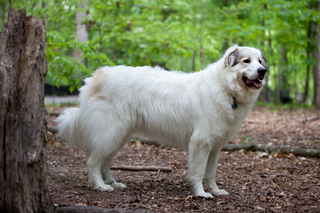
The Pyrenean Mountain Dog is a French breed of livestock guardian dog; in France it is commonly called the Patou. It originates from the eastern or French side of the Pyrenees Mountains that separate France and Spain. It is recognised as a separate breed from the Mastín del Pirineo or Pyrenean Mastiff from the Spanish side of the mountains, to which it is closely related.

The Aidi is a Berber dog breed native to the Atlas Mountains of North Africa and is used as a livestock guardian, protecting herds of sheep and goats. It is most commonly found in Morocco, which holds the standard under the Fédération Cynologique Internationale. The Aidi is also found in Algeria, Tunisia and Libya. It possesses hunting capabilities and good scenting ability. In Morocco, it is often paired in hunting with the Sloughi, which chases down prey that the Aidi has located by scent.

The Serbian Tricolour Hound is a breed of scent hound from Serbia.

A herding dog, also known as a stock dog, shepherd dog, sheep dog or working dog, is a type of dog that either has been trained in herding or belongs to breeds that are developed for herding.

The Pyrenean Sheepdog, the Chien de Berger des Pyrénées in French, is a small to medium-sized breed of herding dog from the Pyrenees Mountains region of France. It is found herding flocks of sheep throughout the Pyrenees alongside the much larger Pyrenean Mountain Dog which is kept as a flock guardian.
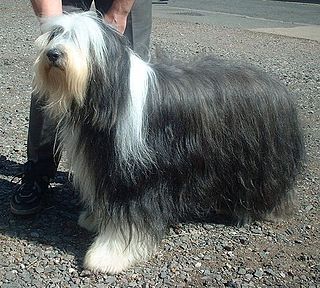
The Bearded Collie, or Beardie, is a herding breed of dog once used primarily by Scottish shepherds, but now mostly a popular family companion.
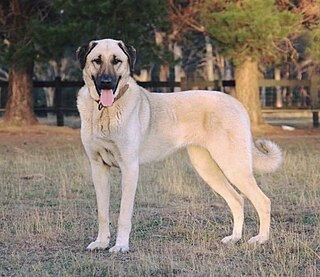
The Kangal Shepherd Dog is a traditional Turkish breed of large livestock guardian dog. The breed name derives from that of the town and district of Kangal in Sivas Province, the easternmost province of the Central Anatolia Region in central Turkey. The coat colour varies from pale fawn to wolf grey, always with a black mask.
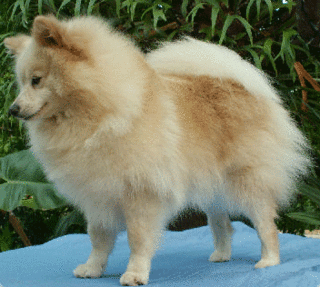
The German Spitz is a breed of spitz-type dogs from Germany. It is considered a single breed, with five distinct varieties based on size and colour: the Wolfsspitz/Keeshond, the Giant Spitz or Großspitz, the Medium Spitz or Mittelspitz, the Miniature Spitz or Kleinspitz and the Pomeranian or Zwergspitz.

The Portuguese Podengo, also known as the Podengo Português or Portuguese Warren Hound, is a hound breed from Portugal. As a breed, the Podengo is divided into three size categories that are not interbred: small (Pequeno), medium (Médio) and large (Grande). Their coats are either short and 'smooth', or longer and 'wired'. The smooth coated variety is traditional, whereas the wire coated variety is an outcome of the assimilation of various other breeds during the 20th century. In general, the breed is healthy; the Pequeno (small) variety has an average lifespan of approximately 15–17 years.
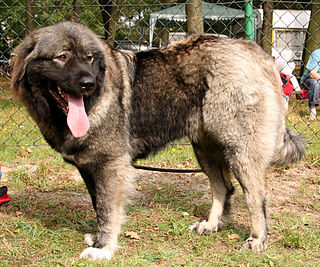
The Caucasian Shepherd Dog or Caucasian Ovcharka is a large livestock guardian dog of Georgian origin, native to the countries of the Caucasus region, notably Georgia, Armenia, Azerbaijan, and Dagestan. It was developed in the Soviet Union from about 1920 from dogs of the Caucasus Mountains and the steppe regions of Southern Russia. The Caucasus Mountains in Georgia have historically been the principal region for distribution of the Caucasian Shepherd.
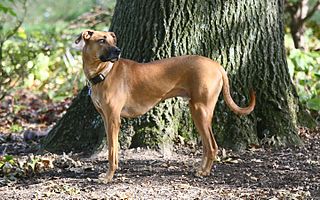
The Black Mouth Cur, also known as the Southern Cur, Southern Black Mouth Cur and the Yellow Black Mouth Cur, is a medium to large sized breed of cur-type dog from the United States. Originating in the south of the country, the breed is a popular hunting companion used to hunt a large variety of game.

The Portuguese Sheepdog is a medium-sized breed of dog of the herding dog type, and is one of the indigenous regional dogs of Portugal. The Portuguese name refers to Serra de Aires, a mountain near Montforte in the Alentejo region. The breed is nicknamed cão macaco for its furry face and lively attitude.
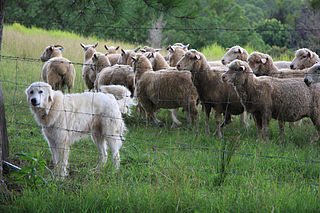
A livestock guardian dog (LGD) is a dog type bred for the purpose of protecting livestock from predators.

The Braque Dupuy, also known as the Dupuy Pointer, was a breed of pointer from the Poitou region of France. It is believed to be extinct.

The Greek Shepherd or Greek Sheepdog is a breed of livestock guardian dog from Greece. Thought to be ancient in origin, the Greek Shepherd is very closely related to livestock guardian dog breeds from neighbouring countries; it is believed that some dogs are simultaneously claimed to be other breeds as they migrate annually across national borders with the flocks they protect in search seasonal pastures.

The West Country Harrier, sometimes called Somerset Harrier, is a breed of scent hound from the south west of England that is used to hunt hare in packs. The West Country Harrier is often considered to be a variety of the more common Harrier breed, which is sometimes referred to as the Studbook Harrier.

The Nenets Herding Laika also known as the reindeer spitz or olenegonka, is an aboriginal spitz landrace of dog originating from the Yamalo-Nenets Autonomous Okrug, in Russia. Unlike other laikas, Nenets Herding Laika are less commonly used for hunting. Instead they have been selected primarily for reindeer herding ability, originally by the Nenets people, and later by reindeer herders through Russia. Nenets herding laika are thought to be the progenitor of several modern breeds, the most well-documented being the Samoyed. Despite this, the breed almost died out during the Soviet era due to lack of interest in preserving genetically purebred examples. In 1994, the Russian Kynologic Federation (RKF) approved the first official standard of the breed.


















